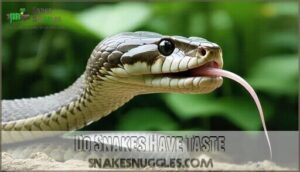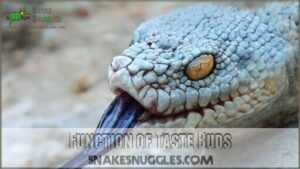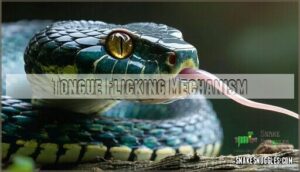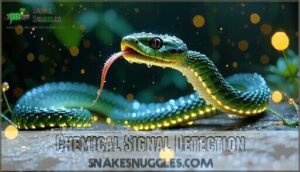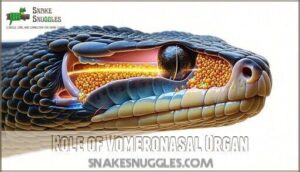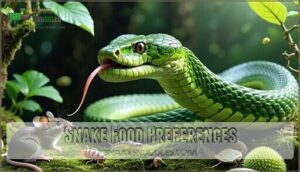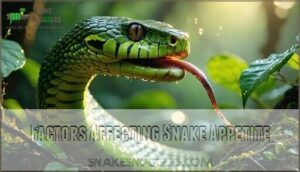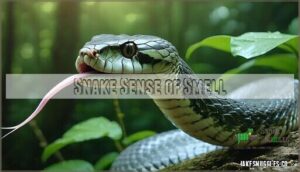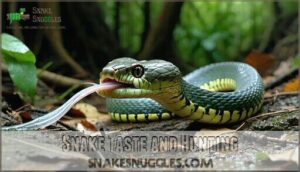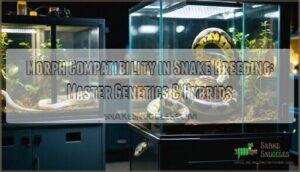This site is supported by our readers. We may earn a commission, at no cost to you, if you purchase through links.
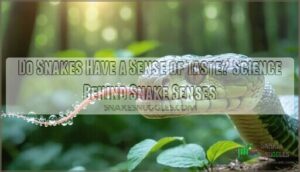 Yes, snakes absolutely have a sense of taste, but it’s nothing like yours.
Yes, snakes absolutely have a sense of taste, but it’s nothing like yours.
They’ve evolved a sophisticated chemical detection system that puts your taste buds to shame.
When you see a snake flicking its forked tongue, it’s collecting airborne molecules and transferring them to the Jacobson’s organ (vomeronasal organ) in its mouth.
This specialized sensory organ processes chemical information, allowing snakes to "taste" their environment in ways that seem almost supernatural.
They can detect prey, predators, and potential mates through microscopic chemical traces.
This tongue-flicking behavior isn’t random—it’s precision sampling that gives snakes detailed information about their surroundings.
What’s fascinating is how this system works differently across species and hunting strategies.
Table Of Contents
- Key Takeaways
- Snake Taste Perception
- Do Snakes Have Taste
- Snake Taste Buds
- How Snakes Taste Food
- Snake Food Preferences
- Factors Affecting Snake Appetite
- Snake Sense of Smell
- Snake Taste and Hunting
- Frequently Asked Questions (FAQs)
- Can snakes taste different flavors like humans do?
- How does a snakes diet affect its sense of taste?
- Can snakes distinguish between edible and inedible objects by taste?
- Do baby snakes have a more developed sense of taste?
- Can snakes taste their own venom?
- Do baby snakes taste differently than adults?
- Can snakes taste water quality or purity?
- Do venomous snakes taste their prey differently?
- Can snakes develop taste preferences over time?
- Conclusion
Key Takeaways
- You don’t taste food the way snakes do – they’ve evolved a sophisticated chemical detection system using their forked tongue and Jacobson’s organ instead of traditional taste buds.
- Your snake’s tongue flicking isn’t random behavior – it’s precision sampling that collects airborne molecules and transfers them to specialized organs for processing environmental information.
- You’ll find snakes rely more on smell than taste for survival – their vomeronasal system can detect prey, predators, and mates through microscopic chemical traces with remarkable accuracy.
- You can’t compare snake taste to human taste since they have fewer taste buds located on their mouth’s roof rather than their tongue, focusing on chemical analysis rather than flavor enjoyment.
Snake Taste Perception
You might think snakes can’t taste their food, but they actually have a sophisticated chemical detection system that combines taste and smell.
Their specialized Jacobson’s organ processes chemical signals collected by their forked tongue, helping them identify prey, avoid danger, and navigate their world with remarkable precision.
Role of Jacobson’s Organ
The Jacobsons organ acts as your snake’s chemical detective, sitting snugly in the roof of its mouth.
This vomeronasal system processes chemical signals collected by tongue flicking, turning molecules into meaningful sensory information.
Through specialized organ structure and sensory processing, it transforms your snake’s world into a rich chemical landscape, making the reptile taste buds and snake sensory system work together seamlessly for enhanced snake taste perception.
The snake’s ability to detect pheromones relies on the vomeronasal system to identify potential mates and prey.
Importance of Smell
While the Jacobson’s organ processes chemical information, your snake’s survival depends heavily on its smell perception. Unlike humans who separate taste and smell, snakes blend these senses through sophisticated olfactory cues and chemical signals from their environment.
Here’s how smell mechanism works in snakes:
- Scent detection occurs when tongue flicking collects airborne molecules
- Environmental smell provides critical information about prey, predators, and mates
- Chemical cues help snakes navigate territory and identify food sources
- Snake smell vs taste shows smell dominates their sensory world completely
Detection of Prey
When you’re hunting for dinner, you don’t just look—you taste the air around you.
Snakes use their forked tongues to collect chemical cues that reveal prey location with remarkable precision.
This chemical detection system transforms hunting strategies into a sophisticated sensory game.
Environmental factors like humidity and temperature affect how well these taste perception mechanisms work, making snake sensory perception incredibly adaptable to different surroundings.
Do Snakes Have Taste
You might wonder if snakes can actually taste their food like you do.
The answer isn’t straightforward – snakes do possess a sense of taste, but it’s fundamentally different from your experience.
Their taste biology operates through specialized sensory systems that combine chemical detection with smell processing.
Snake behavior reveals fascinating adaptations in reptilian taste perception.
Unlike humans who rely on distinct taste sensations, snakes have evolved a more integrated approach to taste sensation in snakes.
Their reptile ecology depends heavily on chemical signals rather than traditional flavor recognition.
The snake sense of taste functions more like a sophisticated chemical analyzer than your familiar sweet, salty, or bitter categories.
When a snake tastes something, it’s basically gathering molecular information about its environment.
This unique snake taste mechanism helps them identify prey, detect predators, and navigate their surroundings with remarkable precision through their specialized sensory apparatus.
Snake Taste Buds
You might be surprised to learn that snakes do have taste buds, but they’re nothing like yours.
While humans have thousands of taste buds scattered across their tongues, snakes have far fewer taste buds located primarily on the roof of their mouths rather than on their tongues.
Location of Taste Buds
Unlike humans, you won’t find snake taste buds scattered across their tongues.
Instead, these specialized taste receptors sit on the mouth roof, particularly around the vomeronasal organ opening.
This taste bud location allows chemical detection when the snake tongue deposits collected molecules.
The Jacobsons organ processes these chemical signals, creating their unique sense of taste through this strategic positioning.
Snakes also rely on ground vibrations for environmental information.
Function of Taste Buds
You’ll find snake taste buds functioning quite differently from your expectations.
These specialized receptors process chemical signals rather than traditional flavors, working alongside the Jacobson’s organ function to detect environmental cues.
Here’s how snake taste bud sensitivity operates:
- Chemical signal processing – Taste buds analyze molecular information from prey and surroundings
- Taste bud location determines sensitivity levels across the oral cavity
- Evolutionary taste changes have shifted focus from flavor perception limits to survival detection
- Reptilian taste preferences develop through chemical recognition rather than enjoyment
- Taste sensation in snakes combines with smell for thorough environmental assessment
Unlike your taste experience, the snake sense of taste prioritizes identifying prey, predators, and mates through chemical signatures.
These adaptations represent millions of years of refinement, transforming taste from a pleasure mechanism into a survival tool that keeps snakes thriving in diverse environments.
Comparison to Human Taste Buds
When comparing snake taste buds to humans, you’ll discover fascinating differences in taste receptors and flavor profiles.
While humans detect five basic tastes through thousands of tastebuds, snakes rely on olfactory cues and their specialized snake tongue for chemical detection rather than traditional sense of taste.
The snake’s chemosensory system utilizes a vomeronasal organ function to detect chemical stimuli in their environment.
| Feature | Human Taste | Snake Taste |
|---|---|---|
| Taste Bud Count | 2,000-8,000 | Up to 40,000 |
| Location | Tongue surface | Tongue pits, palate |
| Primary Function | Flavor detection | Chemical analysis |
Human smell combines with taste for complete flavor profiles, but snakes prioritize survival over savoring meals through their unique chemosensory system.
How Snakes Taste Food
When you watch a snake’s tongue dart in and out, you’re witnessing its primary method for "tasting" the world around it.
This flickering motion isn’t random—it’s a sophisticated chemical detection system that collects airborne molecules and delivers them to specialized organs for processing.
Tongue Flicking Mechanism
You’ll witness something fascinating when you watch a snake’s tongue flicking behavior – it’s nature’s most efficient chemical sampling system in action.
The forked tongue darts out rapidly, collecting airborne molecules through precise tongue movement and sophisticated mouth mechanics.
Here’s how this chemosensory system works:
- Lightning-fast flicks – The tongue extends and retracts in milliseconds, gathering chemical information
- Forked design advantage – Each tip samples different air spaces, creating a stereo effect for directional sensing
- Sticky surface collection – Microscopic particles adhere to the moist tongue surface during each flick
- Controlled withdrawal – The tongue retracts smoothly, carrying collected molecules back inside
- Strategic positioning – Flicking occurs at ideal angles to maximize sensory input from the environment
This remarkable tongue flicking mechanism transforms snakes into living chemical detectors, allowing them to navigate their world through molecular information rather than traditional taste sensations.
Understanding the snake tongue structure is essential for grasping this complex process.
Chemical Signal Detection
When you watch a snake flick its tongue, you’re witnessing sophisticated molecular detection in action.
The forked tongue captures airborne molecules like a biological sensor, transferring chemical signals to specialized neurons.
This chemosensory system processes chemical cues with remarkable precision, enabling pheromone detection and olfactory responses.
Signal processing occurs through dedicated neurotransmitter role pathways that interpret environmental data for survival decisions.
The snake’s ability to analyze its environment is closely tied to snake sensory systems.
| Detection Type | Processing Location | Function |
|---|---|---|
| Airborne molecules | Specialized neurons | Environmental analysis |
| Chemical compounds | Neural pathways | Prey identification |
| Pheromone signals | Brain receptors | Mate recognition |
| Toxin indicators | Sensory cells | Danger assessment |
Role of Vomeronasal Organ
Your snake’s vomeronasal organ acts like a sophisticated chemical laboratory, processing molecules that its forked tongue collects from the environment.
This specialized structure, also called Jacobson’s organ, sits in the roof of the mouth and transforms chemical signals into meaningful information about prey, predators, and mates through dedicated neural pathways.
Vomeronasal Function highlights:
- Organ Structure – Two small chambers lined with sensory cells that analyze chemical compounds
- Chemical Detection – Processes thousands of different molecular signatures simultaneously
- Sensory Processing – Converts chemical data into electrical signals sent directly to the brain
- Neural Pathways – Bypasses normal smell routes, creating a "sixth sense" for chemosensory system navigation
Snake Food Preferences
You might assume snakes are picky eaters, but their food choices work differently than yours.
While smell drives their preferences more than taste, evolution and species variation create fascinating patterns in what different snakes find appetizing, influenced by species variation.
Influence of Smell on Food Choice
Your snake’s nose basically runs the dinner menu – these reptiles rely heavily on olfactory cues rather than traditional taste sensations.
Chemical signals from potential prey trigger scent preferences that guide feeding decisions. Through evolutionary adaptation, snakes developed sophisticated prey detection systems where smell dominates food choice.
This taste and smell interplay means snake feeding habits depend more on recognizing familiar chemical signatures than actual flavor, making prey identification a primarily scent-based survival strategy. Supplementation can address nutritional gaps in diets.
Role of Evolution in Food Preferences
Millions of years ago, your favorite snake’s ancestors could detect sweet and umami flavors just like you do today.
However, evolutionary adaptations stripped away these ancestral receptors as snakes developed specialized chemosensory adaptation systems.
This taste loss wasn’t random—it enhanced survival by focusing on prey toxicity detection rather than flavor evolution, making snake sense of taste perfectly suited for their predatory lifestyle and feeding habits, which is a result of evolutionary adaptations.
Variations in Snake Species
Different snake species show remarkable taste perception diversity based on their lifestyles.
Ball pythons possess enhanced Sensory Adaptations for detecting warm-blooded prey, while sea snakes have specialized taste receptor genes for marine environments.
Dietary Specializations vary dramatically—egg-eating snakes detect calcium-rich shells, whereas venomous species use Venom Variation to assess prey toxicity.
Size Differences affect sensitivity too; larger constrictors need stronger chemical signals than smaller species.
Habitat Influence shapes these adaptations, creating unique taste fingerprints across snake species.
Understanding their preferences involves knowing about appropriate snake diets.
Factors Affecting Snake Appetite
You’ll notice your snake’s appetite can shift dramatically based on several key factors that affect their eating behavior.
Understanding these changes helps you distinguish between normal patterns and potential health concerns that require attention, which is crucial for identifying potential issues early on.
Stress and Appetite
Several factors can trigger snake stress, dramatically affecting their snake appetite and snake feeding behavior.
When you’re caring for snakes, understanding these stressors becomes essential for maintaining healthy food preferences.
Key stress factors that impact snake food consumption include:
- Environmental Imbalance – Incorrect temperature and humidity levels disrupt normal feeding patterns
- Handling Stress – Excessive or improper handling creates anxiety that suppresses appetite
- Temperature Effects – Extreme temperatures impair taste receptor function and prey detection
- Respiratory Issues – Breathing problems alter taste and smell perception, reducing interest in snake food.
Shedding Impact also plays a role, as snakes often refuse food before molting to conserve energy for this demanding process.
Illness and Appetite
When illness strikes, your snake’s chemosensory abilities take a hit, making food less appealing.
Respiratory illness particularly disrupts their delicate taste-smell detection system, while environmental stressors compound the problem.
Temperature sensitivity affects receptor function, and some snakes can even detect toxins in contaminated food sources.
| Illness Type | Impact on Snake Appetite |
|---|---|
| Respiratory Illness | Impairs taste-smell detection, reduces food interest |
| Temperature Stress | Affects receptor sensitivity, alters food preferences |
| Environmental Toxins | Triggers avoidance behaviors, decreases feeding |
| Bacterial Infections | Causes lethargy, suppresses natural hunting instincts |
| Parasitic Load | Weakens overall health, diminishes taste preferences |
Shedding and Appetite
When your snake approaches shedding time, you’ll notice their appetite drops substantially. This pre-shed fasting is completely normal behavior – snakes conserve shedding energy by refusing food days or weeks before molting begins.
The shedding stress affects their taste preferences and overall food preferences during this vulnerable period. Don’t worry if environmental impact seems minimal; appetite recovery typically occurs within days after successful shedding completion.
- Your snake’s cloudy eyes and dull skin signal the start of their fasting period
- Forcing food during pre-shed can cause dangerous regurgitation or stress
- The entire shedding process demands tremendous energy reserves from your pet
- Missing meals for 2-3 weeks won’t harm a healthy adult snake
- Post-shed feeding resumes with renewed vigor and normal snake taste responses
Snake Sense of Smell
You might think snakes can’t smell much, but their sense of smell actually puts yours to shame.
While you rely on your nose to detect odors, snakes use their forked tongues and a specialized organ called Jacobson’s organ to create a chemical map of their world.
That’s far more detailed than what your nose could ever provide, making their sense of smell a unique and powerful tool.
Importance of Smell in Snakes
You’ll find that smell drives everything snakes do.
Their snake olfactory system powers olfactory hunting, letting them track prey across vast distances.
Snake tongue flicking collects chemical data while Jacobsons organ function processes these signals for prey detection and mate recognition.
This sophisticated sense enables environmental navigation and toxin avoidance, making snake tongue function their primary survival tool.
Comparison to Human Sense of Smell
Your nose might be impressive, but it’s no match for a snake’s chemical detection powerhouse.
While you’ve got around 6 million olfactory receptors, snakes pack 300 million into their system.
Their olfactory reliance makes your sense of smell look basic – they’re 10,000 times more sensitive than humans.
This evolutionary adaptation compensates for their limited taste bud count and transforms chemical detection into survival magic.
Role of Jacobson’s Organ in Smell
Your snake’s chemical signal processing happens through the Jacobson’s organ, which acts like a sophisticated chemical laboratory.
When tongue flicking analysis occurs, molecules transfer to this vomeronasal functionality center for pheromone detection.
Environmental cue interpretation becomes possible as the reptile olfactory system processes these chemical cues.
Snake Jacobsons organ studies reveal this sense of smell mechanism far exceeds human capabilities in detecting airborne molecules.
This organ is located on the roof of the mouth.
Snake Taste and Hunting
When you’re tracking a snake’s hunting behavior, you’ll notice their remarkable ability to detect prey through chemical signals collected by their forked tongue.
This specialized hunting system combines tongue flicking with environmental analysis to locate food sources with incredible precision, even in challenging conditions where temperature and humidity affect their sensory capabilities, utilizing their unique system for environmental analysis.
Detection of Prey Through Chemical Signals
Chemical cues act like invisible breadcrumbs leading snakes to their next meal.
When you understand how Prey Scent Tracking works, you’ll see these reptiles follow molecular highways with remarkable precision.
Their snake’s sense of taste combines with sophisticated Chemical Discrimination abilities, allowing Signal Interpretation of prey-specific parvalbumins.
Environmental Influences affect detection sensitivity, while Toxin Detection helps avoid dangerous meals.
This prey detection system transforms snake tongue flicking into chemical reconnaissance missions.
Snakes can even be aided by using enhanced prey odors.
Role of Tongue Flicking in Hunting
You’ll witness your snake’s forked tongue darting in and out like a tiny radar system, collecting airborne molecules that reveal prey locations.
This snake tongue flicking behavior creates detailed chemical maps of the surrounding area, enabling precise prey detection through environmental cues and chemical gradients.
- Hunting efficiency increases dramatically when snakes use sensory integration to process multiple chemical signals simultaneously
- Snake hunting relies on tongue flicking patterns that change based on prey scent strength and direction
- Snake sensory organs work together to transform simple tongue movements into sophisticated tracking systems
Influence of Environment on Taste and Hunting
Environmental conditions dramatically shape how snakes taste and hunt their prey.
Temperature effects influence taste receptor function—extreme heat or cold impairs their chemical detection abilities.
Humidity levels enhance prey moisture detection in wet environments while reducing sensitivity in dry habitats.
These habitat adaptations allow snakes to fine-tune their toxin detection and environmental cues processing for ideal snake food preferences and hunting success.
Frequently Asked Questions (FAQs)
Can snakes taste different flavors like humans do?
Snakes can’t taste different flavors like you do.
They lack traditional taste buds and instead use their forked tongues to collect chemical particles, which their Jacobson’s organ processes for survival-focused chemical detection rather than flavor enjoyment.
How does a snakes diet affect its sense of taste?
A snake’s diet doesn’t substantially alter its taste perception since they rely primarily on smell through their Jacobson’s organ.
However, prey-specific diets may fine-tune their chemosensory system for detecting particular chemical signatures from their preferred food sources.
Can snakes distinguish between edible and inedible objects by taste?
Like a chemical detective with a forked magnifying glass, you’ll find snakes can distinguish edible from inedible objects through their specialized vomeronasal organ and tongue-flicking behavior.
Detecting molecular signatures that signal food safety.
Do baby snakes have a more developed sense of taste?
Baby snakes don’t possess more developed taste perception than adults.
You’ll find their chemosensory systems, including Jacobson’s organ and tongue-flicking behavior, function similarly to mature snakes, relying primarily on smell rather than traditional taste buds.
Can snakes taste their own venom?
You can’t taste your own venom because it’s produced in specialized glands and delivered through hollow fangs, bypassing your mouth’s limited taste receptors and Jacobson’s organ entirely during the strike.
Do baby snakes taste differently than adults?
You’ll find no difference in taste between baby and adult snakes since they lack traditional taste buds.
Their chemical detection system through the Jacobson’s organ functions similarly regardless of age, though sensitivity may vary.
Can snakes taste water quality or purity?
With up to 40,000 taste buds, you’d think snakes could detect water purity, but they can’t taste dissolved chemicals like chlorine or minerals.
Their Jacobson’s organ only processes airborne molecules, not waterborne contaminants affecting quality.
Do venomous snakes taste their prey differently?
Venomous snakes don’t taste prey differently than non-venomous species.
You’ll find they both rely on their Jacobson’s organ and tongue flicking to detect chemical cues, using smell rather than taste to identify potential meals.
Can snakes develop taste preferences over time?
Snakes can develop feeding preferences through repeated exposure to certain prey types, but this isn’t true "taste preference" like humans experience.
You’ll find they rely on chemical detection through their vomeronasal organ rather than flavor enjoyment when choosing food.
Conclusion
Obviously, your smartphone can’t compete with a snake’s chemical detection prowess in terms of taste perception.
Understanding whether do snakes have a sense of taste reveals nature’s remarkable sensory adaptations.
These reptiles don’t taste food like you do—they’ve evolved specialized chemical analysis systems that surpass conventional taste mechanisms.
Their Jacobson’s organ processes molecular information with extraordinary precision, enabling survival through environmental sampling.
This sophisticated sensory integration demonstrates how evolution crafts unique solutions for different ecological challenges, making snake taste perception a fascinating study in biological adaptation.
- https://www.petplace.com/article/reptiles/general/reptile-senses-understanding-their-world
- https://www.quora.com/What-purpose-does-a-snakes-tongue-serve
- https://digitalcommons.hollins.edu/cgi/viewcontent.cgi?article=1063&context=researchawards
- https://www.calacademy.org/sites/default/files/assets/docs/sah_snakes_snake_sense_scents_210722.pdf
- https://www.britannica.com/animal/reptile/Chemoreception

